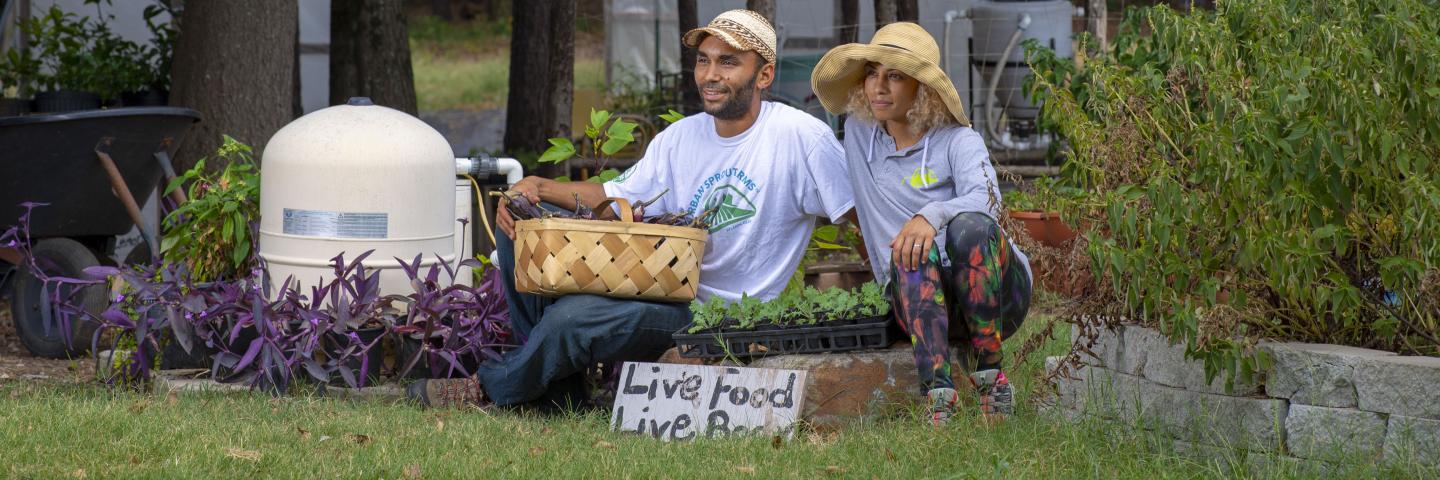
Small-scale practices provide critical access to healthy food for local communities, as well as jobs, increased green spaces, and closer community ties. Urban agriculture includes the cultivation, processing, and distribution of agricultural products in urban and suburban areas. Community gardens, rooftop farms, hydroponic, aeroponic and aquaponic facilities, and vertical production, are all examples of urban agriculture. Small towns may also be included.
The USDA Natural Resources Conservation Service (NRCS) in Pennsylvania supports urban agriculture by providing technical and financial assistance to protect and conserve natural resources. These resources include soil, water, air, plants, animals, and energy. NRCS provides technical and financial assistance for urban growers in areas such as:
- Soil Health
- Water Conservation and Irrigation Improvement
- Weed and Pest Management
- High Tunnels
- Pollinator Habitat

Areas of Focus
NRCS defines natural resources to include soil, water, air, plants, animals, and energy considerations. Check out the Conservation Concerns Tool or make note of the items you’re interested in below to start planning your conservation improvements. Some examples of practices that can address natural resource concerns are italicized.
Soil – reduce or prevent soil erosion; maintain and improve soil health and quality.
Crop Rotation, Cover Crop, Mulching, Residue and Tillage Management
Water - water your crops and/or livestock and improve the water quality on and off your operation; reduce and prevent issues with excess or insufficient water.
Irrigation Water Management, Fence, Watering Facility, Filter Strip, Roof Runoff Structure, Stream Habitat Improvement, Wetland Practices
Air - minimize emissions and drift of particulate matter, pesticides, foul odors, and greenhouse gases on your operation.
Hedgerow, Tree/Shrub Establishment, Field Border, Riparian Forest Buffer, Windbreak/Shelterbelt
Plants - improve productivity and health, increase biodiversity, minimize pests, and reduce wildfire threat.
Nutrient Management, Alley Cropping, Contour Farming, Integrated Pest Management, Forest Stand Improvement, Tree Planting, Conservation Cover, Brush Management, High Tunnel System
Animals - provide feed, forage, water, and shelter for livestock; enhance wildlife habitat or biodiversity.
Forage Planting, Livestock Shelter Structure, Prescribed Grazing, Range Planting, Conservation Cover, Wildlife Habitat Management, Composting Facility, Silvopasture, Waste Management Practices
Energy - improve the energy efficiency of your equipment, facilities, farming/ranching practices, and field operations.
Farmstead Energy Improvement, Field Operations Emissions Reduction
People's Garden
People’s Gardens empower communities to participate in local food production and provide diversity and resiliency to the food supply chain. They also teach about the benefits of sustainable, local agriculture and how gardening can foster community collaboration, provide green gathering spaces, and benefit the environment.
People’s Gardens are different sizes and types based on the needs of the community, and can include school gardens, community gardens, urban farms, and small-scale agriculture projects in rural and urban areas. They cannot be located at private residences.
USDA renewed the People’s Garden movement in 2022 to:

- Celebrate communities growing fresh, healthy food
- Support a resilient, local food system
- Teach people how to garden using sustainable practices
- Nurture habitat for pollinators and wildlife, and greenspace for neighbors
In the current fiscal year, funding is available in Philadelphia, Pennsylvania, and the surrounding metropolitan area to support food-producing gardens with an educational component. You can also learn about the Peoples Garden from USDA experts and beyond who will share planting tips and resources that benefit community gardens. We’ll also share on-the-ground stories of gardens making a difference by growing fresh, nutritious food for their communities. Webinars will be recorded and available for viewing.
Publications
Urban Agriculture at a Glance Brochure
Subscribe to Receive Email and Text Alerts on USDA Small-Scale Practices
USDA Announces Grants for Urban Agriculture and Innovative Production
Watch Our Videos
Let’s Connect
In addition to NRCS, other USDA agencies, including the Farm Service Agency (FSA), Risk Management Agency, and Agricultural Marketing Service (AMS), offer programs and services to urban producers. To learn more:
Visit the Urban Growers webpage on farmers.gov
Visit the AMS Urban Agriculture webpage
Urban Agriculture blogs on farmers.gov


